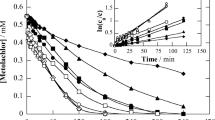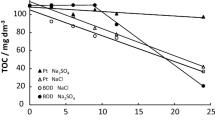Abstract
In this work, the electrochemical degradation of the dye azure B in aqueous solutions was studied by electrochemical advanced oxidation processes (EAOPs), electro-Fenton, and anodic oxidation processes, using Pt/carbon-felt and boron-doped diamond (BDD)/carbon-felt cells with H2O2 electrogeneration. The higher oxidation power of the electro-Fenton (EF) process using BDD anode was demonstrated. The oxidative degradation of azure B by the electrochemically generated hydroxyl radicals (•OH) follows a pseudo-first-order kinetics. The apparent rate constants of the oxidation of azure B by •OH were measured according to pseudo-first-order kinetic model. The absolute rate constant of azure B hydroxylation reaction was determined by competition kinetics method and found to be 1.19 × 109 M−1 s−1. It was found that the electrochemical degradation of the dye leads to the formation of aromatic by-products which are then oxidized to aliphatic carboxylic acids before their almost mineralization to CO2 and inorganic ions (sulfate, nitrate, and ammonium). The evolution of the TOC removal and time course of short-chain carboxylic acids during treatment were also investigated.





Similar content being viewed by others
References
Aarthi T, Narahari P, Madras G (2007) Photocatalytic degradation of Azure and Sudan dyes using nano TiO2. J Hazard Mater 149:725–734
Aguiar A, Ferraz A (2007) Fe3+- and Cu2+-reduction by phenol derivatives associated with Azure B degradation in Fenton-like reactions. Chemosphere 66:947–954
Archibald FS (1992) A new assay for lignin-type peroxidases employing the dye Azure B. Appl Environ Microbiol 58:3110–3116
Brillas E, Casado J (2002) Aniline degradation by Electro-Fenton and peroxi-coagulation processes using a flow reactor for wastewater treatment. Chemosphere 47:241–248
Brillas E, Sirés I, Oturan MA (2009) Electro-Fenton process and related electrochemical technologies based on Fenton’s reaction chemistry. Chem Rev 109:6570–6631
Canizares P, Lobato R, Paz R, Rodrigo MA, Saez C (2005) Electrochemical oxidation of phenolic wastes with boron-doped diamond anodes. Water Res 39:2687–2703
Crini G (2006) Non-conventional low-cost adsorbents for dye removal: a review. Bioresour Technol 97:1061–1085
Daneshvar N, Oladegaragoze A, Djafarzadeh N (2006) Decolorization of basic dye solutions by electrocoagulation: an investigation of the effect of operational parameters. J Hazard Mater 129:116–122
Gnaser H, Savina MR, Calaway WF, Tripa CE, Veryovkin IV, Pellin MJ (2005) Photocatalytic degradation of methylene blue on nanocrystalline TiO2: surface mass spectrometry of reaction intermediates. In J Mass Spectrom 245:61–67
Gregory AR, Elliot J, Kluge P (1981) Ames testing of direct black 38 parallels carcinogenicity testing. J Appl Toxicol 1:308–313
Guivarch E, Oturan MA (2004) The problem of the contamination of waters by synthetic dyes: How to destroy them? Actual Chimique 277–278:65–69
Houas A, Lachheb H, Ksibi M, Elaloui E, Guillard C, Herrmann JM (2001) Photocatalytic degradation pathway of methylene blue in water. Appl Catal B Environ 31:145–157
Kaichouh G, Oturan N, Oturan MA, El Kacemi K, El Hourch A (2004) Degradation of the herbicide imazapyr by Fenton reactions. Environ Chem Lett 2:31–33
Katafias A, Fenska J (2011) Sulfuric acid controlled oxidative degradation of azure B and thionine dyes by cerium(IV). Int J Chem Kinet 43:523–536
Kesraoui-Abdessalem A, Oturan N, Bellakhal N, Dachraoui M, Oturan MA (2008) Experimental design methodology applied to electro-Fenton treatment for degradation of herbicide chlortoluron. Appl Catal B Environ 78:334–341
Lahkimi A, Oturan MA, Oturan N, Chaouch M (2007) Removal of textile dyes from water by the electro-Fenton process. Environ Chem Lett 5:35–39
Lourenço ND, Novais JM, Pinheiro HM (2001) Effect of some operational parameters on textile dye biodegradation in a sequential batch reactor. J Biotechnol 89:163–174
Lyberatos G, Gavala HN, Stamatelatou A (1997) An integrated approach for management of agricultural industries wastewaters. Nonlinear Anal 30:2341–2351
Martinez-Huitle CA, Brillas E (2009) Decontamination of wastewaters containing synthetic organic dyes by electrochemical methods: a general review. Appl Catal B Environ 87:105–145
Martins MAM, Lima N, Silvestre AJD, Queiroz MJ (2003) Comparative studies of fungal degradation of single or mixed bioaccessible reactive azo dyes. Chemosphere 52:967–973
Nasr B, Abdelatif G, Cañizares P, Sáez C, Lobato J, Rodrigo MA (2005) Electrochemical oxidation of hydroquinone, resorcinol, and catechol on boron-doped diamond anodes. Environ Sci Technol 39:7234–7239
Oturan MA (2000) Ecologically effective water treatment technique using electrochemically generated hydroxyl radicals for in situ destruction of organic pollutants: application to herbicide 2,4-D. J Appl Electrochem 30:475–482
Oturan MA, Sirés I, Oturan N, Pérocheau S, Laborde J-L, Trévin S (2008) Sonoelectro-Fenton process: a novel hybrid technique for the destruction of organic pollutants in water. J Electroanal Chem 624:329–332
Oturan N, Panizza M, Oturan MA (2009) Cold incineration of chlorophenols in aqueous solution by electro-Fenton process. Effect of number and position of chlorine atoms on the degradation kinetics. J Phys Chem A 113:10988–10993
Oturan MA, Oturan N, Edelahi MC, Podvorica FI, El Kacemi K (2011) Oxidative degradation of herbicide diuron in aqueous medium by Fenton’s reaction based advanced oxidation processes. Chem Eng J 171:127–135
Oturan N, Brillas E, Oturan MA (2012) Unprecedented total mineralization of atrazine and cyanuric acid by anodic oxidation and electro-Fenton with a boron-doped diamond anode. Environ Chem Lett 10:165–170
Özcan A, Şahin Y, Koparal AS, Oturan MA (2008a) Degradation of picloram by the electro-Fenton process. J Hazard Mater 153:718–727
Özcan A, Şahin Y, Savaş Koparal A, Oturan MA (2008b) Carbon sponge as a new cathode material for the electro-Fenton process: comparison with carbon felt cathode and application to degradation of synthetic dye basic blue 3 in aqueous medium. J Electroanal Chem 616:71–78
Panizza M (2009) Direct and mediated anodic oxidation of organic pollutants. Chem Rev 109:6541–6569
Panizza M, Cerisola G (2005) Application of diamond electrodes to electrochemical processes. Electrochim Acta 51:191–199
Pazarlioglu NK, Urek RO, Ergun F (1923–1929) Biodecolourization of direct blue 15 by immobilized Phanerochaete chrysosporium. Process Biochem 2005:40
Pignatello JJ, Oliveros E, MacKay A (2006) Advanced oxidation processes for organic contaminant destruction based on the fenton reaction and related chemistry. Crit Rev Env Sci Technol 36:1–84
Robinson T, McMullan G, Marchant R, Nigam P (2001) Remediation of dyes in textile effluent: a critical review on current treatment technologies with a proposed alternative. Bioresour Technol 77:247–255
Rodrigo MA, Canizares P, Sanchez-Carretero A, Saez C (2010) Use of conductive diamond electrochemical oxidation for wastewater treatment. Catal Today 151:173–177
Rodríguez Couto S, Domínguez A, Sanromán A (2002) Photocatalytic degradation of dyes in aqueous solution operating in a fluidised bed reactor. Chemosphere 46:83–86
Rosales E, Sanroman MA, Pazos M (2012) Application of central composite face-centered design and response surface methodology for the optimization of electro-Fenton decolorization of Azure B dye. Environ Sci Pollut Res 19:1738–1746
Salazar R, Brillas E, Sires I (2012) Finding the best Fe2+/Cu2+ combination for the solar photoelectro-Fenton treatment of simulated wastewater containing the industrial textile dye Disperse Blue 3. Appl Catal B Environ 115:107–116
Sirés I, Oturan N, Oturan MA (2010) Electrochemical degradation of β-blockers. Studies on single and multicomponent aqueous solutions. Water Res 44:3109–3120
Wainwright M (2005) The development of phenothiazinium photosensitisers. Photodiagn Photodyn 2:263–272
Wang A, Qu J, Ru J, Liu H, Ge J (2005) Mineralization of an azo dye acid red 14 by electro-Fenton’s reagent using an activated carbon fiber cathode. Dyes Pigm 65:227–233
Zhou M, He J (1902–1910) Degradation of azo dye by three clean advanced oxidation processes: wet oxidation, electrochemical oxidation and wet electrochemical oxidation—a comparative study. Electrochim Acta 2007:53
Zhou M, Yu Q, Lei L, Barton G (2007) Electro-Fenton method for the removal of methyl red in an efficient electrochemical system. Sep Purif Technol 57:380–387
Zollinger, H (1991) Color chemistry. Synthesis, properties and applications of organic dyes and pigments, Wiley-VHCA
Acknowledgments
Hugo Olvera Vargas would like to thank the European Commission for the financial support through the Erasmus Mundus Joint Doctorate Programme ETeCoS3, Université Paris-Est, as well as the program VINCI 2012. C.T. Aravindakumar acknowledges Université Paris-Est Marne-la-Vallée for the invited Professor position.
Author information
Authors and Affiliations
Corresponding authors
Additional information
Responsible editor: Philippe Garrigues
Rights and permissions
About this article
Cite this article
Olvera-Vargas, H., Oturan, N., Aravindakumar, C.T. et al. Electro-oxidation of the dye azure B: kinetics, mechanism, and by-products. Environ Sci Pollut Res 21, 8379–8386 (2014). https://doi.org/10.1007/s11356-014-2772-4
Received:
Accepted:
Published:
Issue Date:
DOI: https://doi.org/10.1007/s11356-014-2772-4




